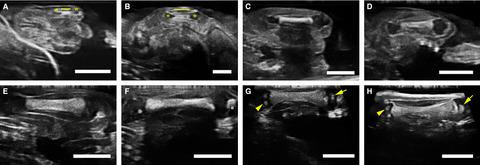Our official English website, www.x-mol.net, welcomes your
feedback! (Note: you will need to create a separate account there.)
Fetal bone development in the lowland paca (Cuniculus paca, Rodentia, Cuniculidae) determined using ultrasonography.
Journal of Anatomy ( IF 1.8 ) Pub Date : 2020-04-07 , DOI: 10.1111/joa.13184 Gessiane Pereira da Silva 1 , Frederico Ozanan Barros Monteiro 1 , Thyago Habner de Souza Pereira 1 , Sandy Estefany Rodrigues de Matos 1 , Rafael Dos Santos de Andrade 1 , Hani Rocha El Bizri 2, 3, 4, 5 , Leandro Nassar Coutinho 1 , João Valsecchi 2, 3, 4 , Carlos López-Plana 6 , Pedro Mayor 1, 3, 6, 7
Journal of Anatomy ( IF 1.8 ) Pub Date : 2020-04-07 , DOI: 10.1111/joa.13184 Gessiane Pereira da Silva 1 , Frederico Ozanan Barros Monteiro 1 , Thyago Habner de Souza Pereira 1 , Sandy Estefany Rodrigues de Matos 1 , Rafael Dos Santos de Andrade 1 , Hani Rocha El Bizri 2, 3, 4, 5 , Leandro Nassar Coutinho 1 , João Valsecchi 2, 3, 4 , Carlos López-Plana 6 , Pedro Mayor 1, 3, 6, 7
Affiliation

|
Studying the timing of the main events of embryonic and fetal development may clarify the strategies adopted by species to maximize neonatal survival and the consequences of these events for their life history. This study describes bone development during the fetal phase of the lowland paca (Cuniculus paca ), comparing it with other precocial or altricial species, and its relationship with the species’ adaptive strategies. A total of 102 embryos/fetuses obtained over the course of 17 years through collaboration with local subsistence hunters in the Amazon were analyzed. Measurements of mineralization of the axial and appendicular skeletons were performed by ultrasonography using a 10–18‐MHz linear transducer. The chronological order of occurrence of mineralization in relation to the total dorsal length (TDL) was: skull (TDL = 4.1 cm); vertebral bodies (TDL = 4.6 cm); scapula, humerus, radius, ulna, ilium, ischium, femur, tibia, and fibula (TDL = 6.7 cm); ribs (TDL = 7.8 cm); clavicle (TDL = 8.5 cm); metacarpi/metatarsi (TDL = 11 cm); phalanges (TDL = 15 cm); tarsus (TDL = 18 cm); patella (TDL = 23 cm); and carpus (TDL = 27.2 cm). Secondary ossification centers first appeared in the femoral distal epiphysis (TDL = 16.6 cm) and tibial proximal epiphysis (TDL = 18.4 cm). Advanced fetuses (TDL > 30 cm, 97% gestational period) presented mineralization in all primary and most secondary centers. Compared to other species, paca neonates have a well‐developed skeletal system at birth, which is important for their independent postnatal locomotion. Our results may contribute to the monitoring of bone development in other wild species, helping us to understand their life history, and serving as parameters for comparisons between precocial and altricial mammals.
中文翻译:

使用超声检查确定低地 paca (Cuniculus paca、Rodentia、Cuniculidae) 中的胎儿骨发育。
研究胚胎和胎儿发育主要事件的时间可能会阐明物种为最大限度地提高新生儿存活率而采取的策略以及这些事件对其生活史的影响。这项研究描述了低地帕卡 ( Cuniculus paca ) 胎儿期的骨骼发育),将其与其他早熟或早熟物种进行比较,以及它与物种适应策略的关系。通过与亚马逊当地的自给猎人合作,在 17 年的时间里总共获得了 102 个胚胎/胎儿进行了分析。使用 10-18-MHz 线性传感器通过超声检查测量轴向和附肢骨骼的矿化。与总背长(TDL)相关的矿化发生的时间顺序是:头骨(TDL = 4.1 cm);椎体(TDL = 4.6 cm);肩胛骨、肱骨、桡骨、尺骨、髂骨、坐骨、股骨、胫骨和腓骨(TDL = 6.7 cm);肋骨(TDL = 7.8 厘米);锁骨(TDL = 8.5 厘米);掌骨/跖骨(TDL = 11 厘米);指骨(TDL = 15 厘米);跗骨(TDL = 18 厘米);髌骨(TDL = 23 厘米);和腕骨(TDL = 27.2 厘米)。次生骨化中心首先出现在股骨远端骨骺(TDL = 16.6 cm)和胫骨近端骨骺(TDL = 18.4 cm)。晚期胎儿(TDL > 30 cm,97% 妊娠期)在所有初级和大多数次级中心都呈现矿化。与其他物种相比,paca 新生儿在出生时具有发达的骨骼系统,这对其独立的产后运动非常重要。我们的研究结果可能有助于监测其他野生物种的骨骼发育,帮助我们了解它们的生活史,并作为比较早熟哺乳动物和晚熟哺乳动物的参数。97% 妊娠期)在所有初级和大多数二级中心呈现矿化。与其他物种相比,paca 新生儿在出生时具有发达的骨骼系统,这对其独立的产后运动非常重要。我们的研究结果可能有助于监测其他野生物种的骨骼发育,帮助我们了解它们的生活史,并作为比较早熟哺乳动物和晚熟哺乳动物的参数。97% 妊娠期)在所有初级和大多数二级中心呈现矿化。与其他物种相比,paca 新生儿在出生时具有发达的骨骼系统,这对其独立的产后运动非常重要。我们的研究结果可能有助于监测其他野生物种的骨骼发育,帮助我们了解它们的生活史,并作为比较早熟哺乳动物和晚熟哺乳动物的参数。
更新日期:2020-04-07
中文翻译:

使用超声检查确定低地 paca (Cuniculus paca、Rodentia、Cuniculidae) 中的胎儿骨发育。
研究胚胎和胎儿发育主要事件的时间可能会阐明物种为最大限度地提高新生儿存活率而采取的策略以及这些事件对其生活史的影响。这项研究描述了低地帕卡 ( Cuniculus paca ) 胎儿期的骨骼发育),将其与其他早熟或早熟物种进行比较,以及它与物种适应策略的关系。通过与亚马逊当地的自给猎人合作,在 17 年的时间里总共获得了 102 个胚胎/胎儿进行了分析。使用 10-18-MHz 线性传感器通过超声检查测量轴向和附肢骨骼的矿化。与总背长(TDL)相关的矿化发生的时间顺序是:头骨(TDL = 4.1 cm);椎体(TDL = 4.6 cm);肩胛骨、肱骨、桡骨、尺骨、髂骨、坐骨、股骨、胫骨和腓骨(TDL = 6.7 cm);肋骨(TDL = 7.8 厘米);锁骨(TDL = 8.5 厘米);掌骨/跖骨(TDL = 11 厘米);指骨(TDL = 15 厘米);跗骨(TDL = 18 厘米);髌骨(TDL = 23 厘米);和腕骨(TDL = 27.2 厘米)。次生骨化中心首先出现在股骨远端骨骺(TDL = 16.6 cm)和胫骨近端骨骺(TDL = 18.4 cm)。晚期胎儿(TDL > 30 cm,97% 妊娠期)在所有初级和大多数次级中心都呈现矿化。与其他物种相比,paca 新生儿在出生时具有发达的骨骼系统,这对其独立的产后运动非常重要。我们的研究结果可能有助于监测其他野生物种的骨骼发育,帮助我们了解它们的生活史,并作为比较早熟哺乳动物和晚熟哺乳动物的参数。97% 妊娠期)在所有初级和大多数二级中心呈现矿化。与其他物种相比,paca 新生儿在出生时具有发达的骨骼系统,这对其独立的产后运动非常重要。我们的研究结果可能有助于监测其他野生物种的骨骼发育,帮助我们了解它们的生活史,并作为比较早熟哺乳动物和晚熟哺乳动物的参数。97% 妊娠期)在所有初级和大多数二级中心呈现矿化。与其他物种相比,paca 新生儿在出生时具有发达的骨骼系统,这对其独立的产后运动非常重要。我们的研究结果可能有助于监测其他野生物种的骨骼发育,帮助我们了解它们的生活史,并作为比较早熟哺乳动物和晚熟哺乳动物的参数。















































 京公网安备 11010802027423号
京公网安备 11010802027423号